Canon Powershot SX50 HS Review
Canon Powershot SX50 HS Introduction
The Canon Powershot SX50 HS is a 12 megapixels ultra-zoom that features the most powerful optical zoom lens ever made into a digital camera. At 50X, the lens of the SX50 HS has a reach equivalent to 24-1200mm, going from ultra-wide to well-beyond telephoto. Not only can this lens frame the moon tightly, it can also focus down to 0cm at wide-angle, which is only matched by a handful of other SX-series cameras.
As a prosumer model, the SX50 HS offers a well-rounded feature-set with full-manual controls, including manual focus, spot metering and custom white-balance. It also fits in a small EVF and 2.8" rotating LCD, plus a hot-shoe for external lighting.
Surprisingly, this digital camera is not much bigger than the majority of its competitors, despite sporting almost twice the zoom as some. The SX-series always been strongly oriented towards video and this one is no exception with full 1080p HD video capture and a built-stereo microphone.
Canon launched the SX50 HS shortly after the SX500 IS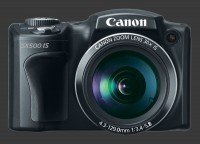
Canon Powershot SX500 IS packs a whopping 30X optical zoom lens in a smaller body which neither has an EVF nor a hot-shoe. The SX500 also uses a 16 MP CCD rather than 12 MP CMOS, so watch for the extra zero in the model name when comparing.
This express digital camera review analyses the features, ergonomics, usability, performance and image quality of the Canon Powershot SX50 HS.
Canon Powershot SX50 HS Features
Sensor & Exposure
- 12 Megapixels CMOS sensor
- ISO 80 to 6400 sensitivity
- 1/2000 - 15sISO locked at 80 for shutter-speeds slower than 1s. Shutter-speeds
- PASM Exposure modes
- Multi-Segment, Center-Weight & Spot metering
- Exposure-Compensation, ±3 in 1/3 EV increments
- Flash-Compensation, ±2 in 1/3 EV increments
- Exposure Bracketing, 3 frames, maximum ±2 EV
- Auto, On, Off or Slow-Sync Flash Modes
- First or second curtain Flash-Sync
- Optional redeye correction and lamp
Lens
- 50X Optical zoom range
- Ultra-wide 24mm to 1200mm equivalent
- Built-In Stabilization, Shooting-Only or Continuous
- F/3.4 - 6.5 Maximum aperture
- F/8 Minimum aperture
Image Parameters
- Automatic, 6 presetsSunny, Cloudy, Tungsten, Fluorescent, Fluorescent Hight, Flash and custom white-balance
- WB Fine-Tuning, 19 steps along 2 axis
- Normal colors, plus 8 color and 2 B&W modes
- Adjustable Contrast, Sharpness, Saturation, Red, Green, Blue and Skin Tone, 5 steps each
- Noise-Reduction, 3 levels
- Optional Shadow Correction
- Optional Dynamic Range Correction, 2 levels
Video
- 1920x1080 @ 24 FPS video
- 1280x720 and 640x480 @ 30 FPS video
- 640x480 @ 120 FPS and 320x240 @ 240 FPS high-speed video
- Center or Face-Detect Autofocus
- Built-in stereo microphone
Focus
- Single-Shot, Continuous, Tracking or Face-Detect
- 5cm - 2mTowards middle of zoom. Near telephoto, minimum distance is 1.3m. Normal minimum focus distance
- 0cm Macro minimum focus distance
- Focus Bracketing, 3 frames, 3 step-sizes
- Optional AF-Assist lamp
Drive
- Single-shot
- 13 FPS Continuous, Max 10 shots, HS-Burst, AF Locked at first frame
- 4.1 FPS Continuous, Max 10 shots, HS-Burst,
- 2.2 FPS Continuous, Max 10 shots, PASM modes, AF Locked at first frame
- 0.8 FPS Continuous, Max 10 shots, PASM modes
- Self-Timer, 2s or 10s or 1-10 Shots @ 0-30s
Display & Viewfinder
- 2.8" Rotating LCD, 460K Pixels, 100% Coverage
- 0.2" EVF, 200K Pixels, 100% Coverage
- Exposure-Priority on half-press, except M mode
- Full-time Exposure-Priority in M mode
- Single-Axis Digital-Level
- Adjustable LCD brightness
- Framing-Assist view
Connectivity
- Wired Remote, sold-separately
- HDMI (1080i) output
- A/V (NTSC / PAL) output
- USB 2.0 connectivity
Misc
- Built-in HDR
- Panorama Assist Mode
- Customizable Short-Cut button
- Lithium-Ion battery
- SDXC memory
Canon Powershot SX50 HS Usability - How easy is it to use?
The Canon Powershot SX50 HS has a classic ultra-zoom style which looks like a miniaturized DSLR. The huge 50X optical zoom lens takes space but not as much as one would expect. A fixed 2" metal lens barrel protrudes from the camera body and the lens extends up to 2½" further when fully extended.
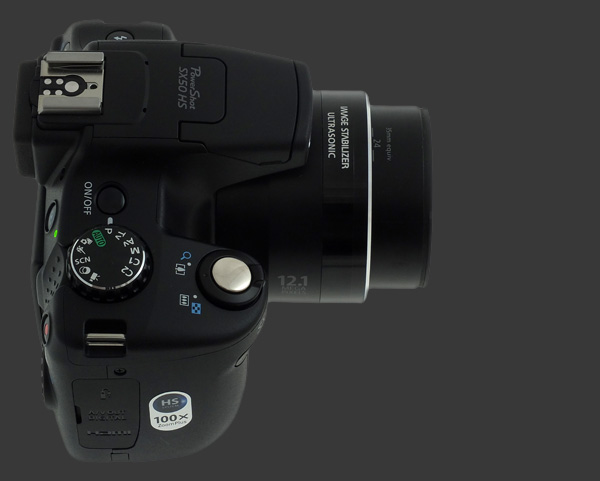
A sticker on the side shows that digital zoom is alive, proclaiming 100X zoom. As usual, just ignore this.
Ergonomics
This digital camera has a deep sculpted hand-grip which makes it comfortable to hold securely. This is quite important for an ultra-zoom since it improves stability which is needed towards the long end of the zoom. The solid lens barrel another point of support to use the SX50 HS with both hands. The camera feels solid, except for the hinge of the rotating LCD which seems like it could break off easily. The camera is light enough to carry around for prolonged periods.
The hand-grip includes a well-placed two-stage shutter-release. It has a short travel with a firm halfway point. The full-press is just a hair lower. Around it is a rotating variable speed electronic zoom-controller. There are relatively fine-steps to the zoom but the controller has enough resistance that it is difficult to finely adjust the zoom. This is the only truly frustrating usability aspect of this camera and causes a lot of back-and-forth motion to get framing perfect, if it is even possible.

The top of the Powershot SX50 HS has a true mode-dial with 12 positions. It is easy to move using your thumb while holding the camera securely. The dial has good detents which means it will not move accidentally either. The classic PASM exposure-modes are there, plus two custom modes, a fully automatic one, various ways of using Scene modes, including HDR, and a dedicated video mode.
Next to the mode-dial is a simple modeless power button. It serves to turn on the camera or wake it up from sleep mode. The difference is that it moves back the lens to its previous position when waking up. The power-save function is rather aggressive to maintain below average battery-life, so it is not recommended to turn it off.
One can see the standard hot-shoe and the two tiny holes that form the built-in stereo microphone just behind the popup flash. On the left side of the camera a button is used to bring up the Flash-Mode menu. The SX50 HS has a manually-released flash, so the camera cannot simply decide to use it without user-consent.
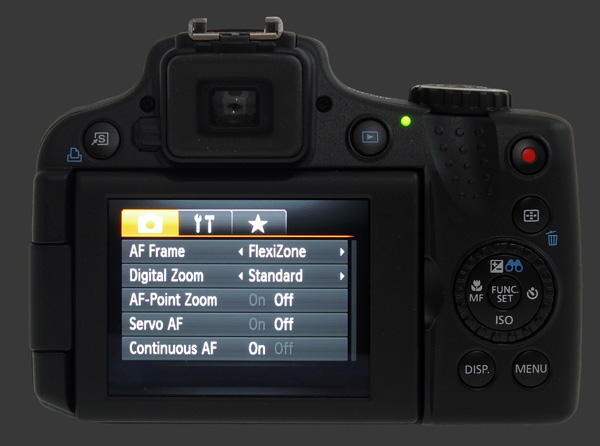
Most remaining controls are found on the back of the camera. There is a reasonable number of those, although only one rather thin control-dial. It moves easily with soft detents. Because it is so flat though, it is unfortunately nearly impossible to move it while using gloves.
At the center of the control-dial is the 4-way controller with a central button. The central button invokes Canon's intuitive Function menu. This vertical menu is extremely efficient to use and stays up even when the shutter is released, making trying different settings quick. One selects a setting to change with the vertical directions of the 4-way controller and sets it with the horizontal directions. Pressing the Function button again dismisses the Function menu but there is no need to confirm
Outside of menus, each direction of the 4-way controller is assigned a function:
- Up: Brings up the EC scale. The control-dial can then be used to set the amount of EC. Pressing Disp brings up the AEB scale. Rotating the control-dial, sets the bracketing increment. Bringing it to zero turns off AEB.
- Right: Sets the Self-Timer. One can select Off, 2s, 10s or Custom. The neat thing is that Canon lets users setup the custom timer right there by pressing the Menu button.
- Down: Down shows the ISO scale with Auto at one end and options from ISO 80 to 6400 in 1/3 stops. Pressing Disp jumps to Auto ISO.
- Left: Selects between Macro, Normal or Manual Focus. To focus manually, use the vertical directions of the 4-way controller. Optionally, the SX50 HS shows a magnified view to assist focusing. Still, the EVF is too small to evaluate fine differences, so use of the LCD is highly recommended when focusing manually.
The Playback and Menu buttons, still on the back of the camera, work exactly as expected. The Disp button cycles between available display modes. In Capture mode, this unfortunately includes all the modes twice, once for the LCD and once for the EVF. This makes cycling a bit of a pain as you have to jump over two unused modes to get back to where you were. There is no way around this since the SX50 HS does not have a toggle for the viewfinder and no Eye-Start sensor either.
In Playback mode, very little information is shown with images by default. To see any exposure-related data, the Disp button must be pressed until it appears. This shows a luminance-only histogram. Press the Up direction, swaps exposure-data for RGB histograms.
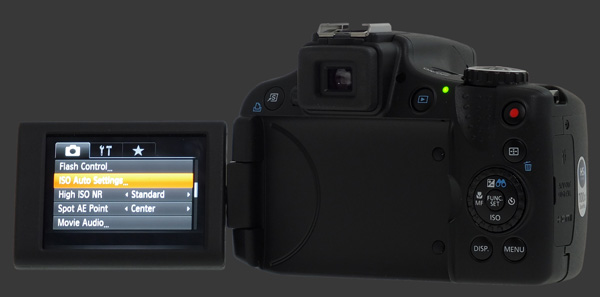
Just above the 4-way controller is the Focus-Point Selection button. Once pressed, the focus area can be moved around almost anywhere in the frame. Pressing Disp toggles between small and large areas. Higher, there is a dedicated Video-Record button. This button starts and stops video recording but is worse than redundant as the SX50 HS has an actual Video mode. In Video mode, recording starts instantly when the shutter-release is pressed, so the Video-Record button is not needed. In other modes, one can press the Video-Record button to start recording after a 1¾s delay and you cannot properly frame video because the LCD and EVF each show the framing for images. We therefore suggest the Video-Record button be left alone.
The last control on the back is the Shortcut button. There are 15 options: iContrast, WB, One-Touch Custom WB 1, One-Touch Custom WB 2, My Colors, Drive Mode, FC, Metering, Aspect-Ratio, RAW+JPEG, Servo, AFL, AEL, Digital Zoom and Display Off. Plenty of these options are settable via the efficient Function menu. Both One-Touch options are particularly interesting. They measure and set WB simultaneously. This makes it a breeze to set WB from a reference. One option which is notably missing though is Stabilization. Luckily, the Powershot SX50 HS automatically turns off stabilization when it detects that it is mounted on a tripod.
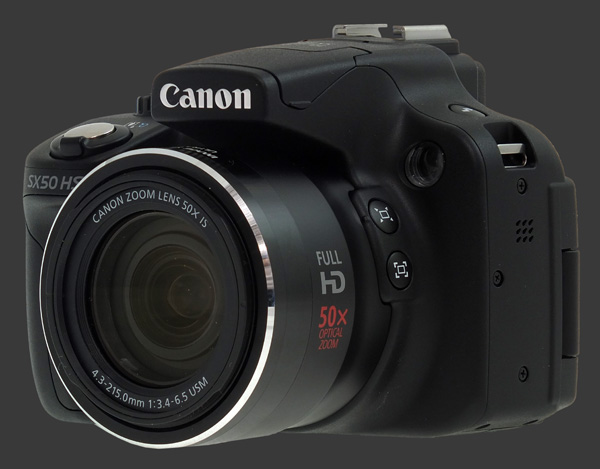
The outer side of the lens barrel has two buttons. The upper one is unique Framing Assist button. Anyone who tried to frame distant subjects with a super-telephoto lens knows that it is very difficult to aim. Framing Assist is designed to help with this by temporarily zooming out the lens. When pressed, the lens zooms out and shows an outline corresponding to the set zoom. This lets the photographer point the camera, ensuring the desired subject appears within the frame. Releasing the Framing Assist button, zooms the lens back to where it was. This is a clever approach and shows that Canon was thinking about the difficulties of using such an extreme zoom.
During Framing Assist, you can adjust the target zoom area should the subject not be properly framed by the original zoom level. A second button below Framing Assist is there to tell the stabilizer to try to keep the current framing. This Lock button directs the stabilizer to counteract shake with movements towards the center of the frame.
Functionality
As shown in the introduction of this review, the Canon Powershot SX50 HS has a full complement of manual controls. Here we cover less common functions and behavior which is not typical.
While this camera has an official shutter-speed range of 1/2000-15s, it only supports the full range at ISO 80. Above that, speeds are limited to 1s and this includes an exposure as a result of AEB. When setting shutter-speed, the camera highlights the ISO when it changes. It gives no warning for AEB though which can result in multiple identical frames in a bracket.
A more typical feature interaction occurs with Dynamic Range Correction. When the option is set to 200%, only ISO 200 and up can be chosen. With 400%, its ISO 400+. There are no such limitations with Shadow Correction.
Fully Auto mode locks up EC, ISO and Focus. There are a total of 11 scene modes, spread around various locations. The notable ones are:
- Panorama Assist: This is the classic mode to assist with alignment of images and lock all camera settings while capturing images to be stitched together later.
- Hand-Held Night-Scene: This one grabs a burst of images and performs multi-frame noise-reduction to make things cleaner.
- HDR: Captures details in a high contrast scene but shooting a 3-frame AEB and blending the resulting images together.
Display & Viewfinder
This ultra-zoom includes a 2.8" LCD with 460K pixels mounted on a rotating hinge. This makes it possible to shoot self-portraits but puts the display in a more precarious position when shooting at high or low angles. Visibility is good with enough resolution to confirm focus in most cases.
The displays shows a bright image most of the time. While the shutter is half-pressed, it shows an Exposure-Priority preview and adjusts the histogram accordingly. Since the histogram is not reliable before that, it would have been better if it simply appeared when correct. In Manual mode though, the display is always Exposure-Priority and the histogram accurate. This is considerably better than the majority of cameras reviewed lately,
Everything shown on the LCD can also be seen on the EVF. The precision of the EVF is much lower and its tiny size makes it much harder to use. At least it there for use in bright light. It is too bad Canon did not put a more usable EVF as it gives more stability while shooting.
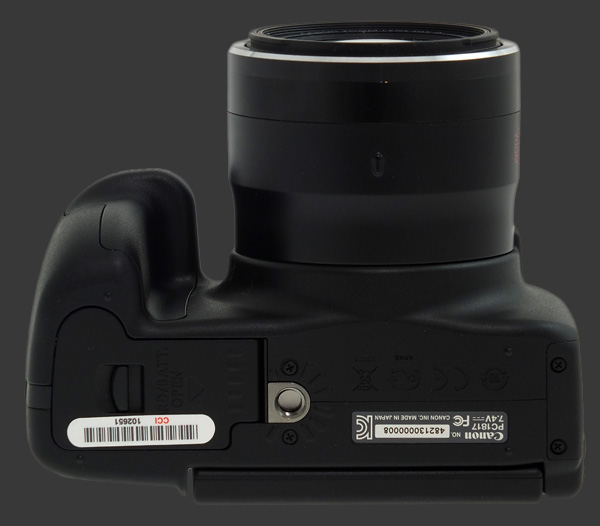
Misc
There is metal tripod mount at the bottom of this digital camera. It is not aligned with the optical center of the lens which is problematic for panoramic photography. The camera is powered by a proprietary Lithium-Ion battery and accepts SDXC memory cards. A solid door at the bottom of the camera gives access to both.
Canon Powershot SX50 HS Performance - How well does it take pictures?
Performance starts with image quality, which is the criteria used as the foundation of our digital camera ratings. Ergonomic issues may get in the way, but in the end, image quality counts the most. The Canon SX50 HS uses a small 1/2.3" sensor to achieve such a long zoom which limits image quality but this is the latest generation of CMOS sensors and resolution was capped at a reasonable 12 megapixels.
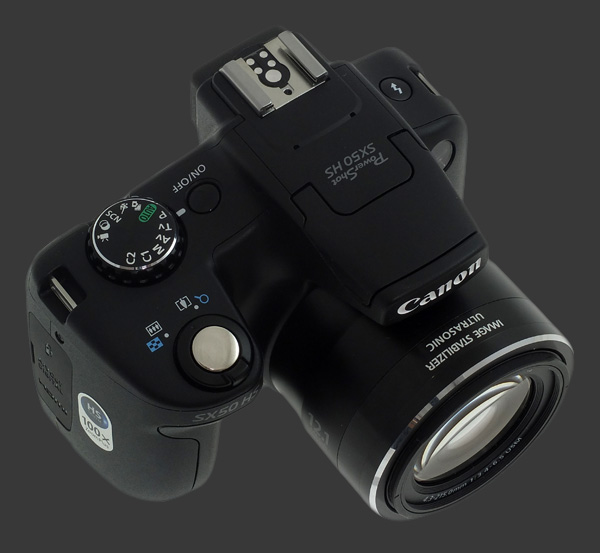
Image Quality
The SX50 HS has an ISO range from 80 to 6400 with noise apparent at all sensitivities. From ISO 80 to 200, the noise is very fine-grained at has little effect on image details. With noise-reduction at Normal, images still retain a good amount of details with a noise cleaned nicely. The Low setting is quite noisy and the High setting leaves things looking like plastic, so the default is perfect. Since the SX50 HS supports RAW capture, one can perform their own noise-reduction instead.
For the largest prints, definitely stick to ISO 80 or 100 which produce very usable results. At ISO 200, noise is more obvious but a moderately large print is still possible. ISO 400 and 800 suffer from loss of fine-details, reducing print sizes to more common ones, up to about 9" x 12". ISO 1600 is the last really usable sensitivity and makes some reasonable small prints.
While image-noise is on par with most ultra-zooms, the SX50 HS manages to retain more details than all such digital cameras except for the Fuji X-S1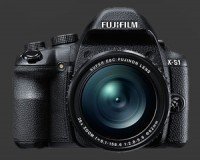
Fujifilm X-S1. The side-by-side comparison shows this on the Indoor ISO page. Still, second place is very good considering the Canon has almost twice as much zoom as the Fuji.
The 50X optical zoom lens of the SX50 HS is impressive. It delivers rather good sharpness with a gentle drop-off towards the corners of the frame. This is mostly visible near wide-angle. Even towards the long end of the zoom things do not get much softer, only dimmer with a maximum aperture of F/6.5.
Distortion is only high at wide-angle and disappears quickly after zooming in. There are no signs of vignetting or chromatic aberrations either. The SX50 HS may be correcting this via internal processing but results speak for themselves. Canon really outdid themselves here.
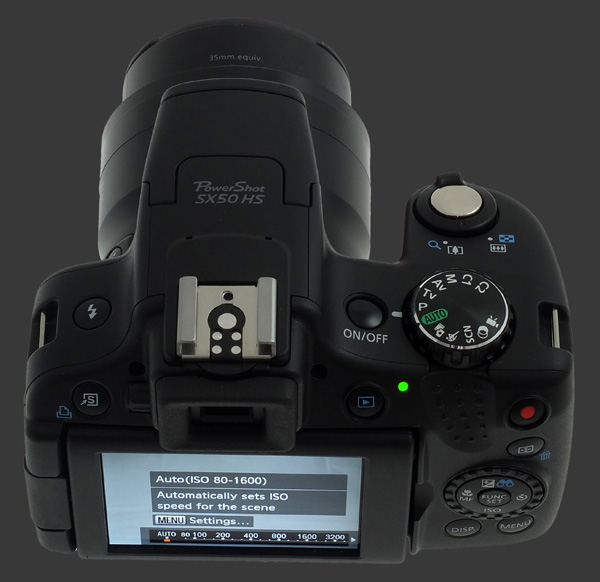
Color are not entire accurate and deliver punchy results with some over-saturation but not too much. There are My Color modes to improve things and we found most pleasant results with Saturation dialed-down one step. The internal processing leaves things a little soft by default and adding one to Sharpness helps, only showing a slight amount of sharpening artifacts.
Automatic white-balance is excellent and copes with with a variety of lighting, including typical indoor one. For difficult situations, which are rare with the SX50 HS, there is a reliable custom white-balance function too. With the Shortcut button set to one of the custom white-balance memories, it is extremely efficient to use.
The Canon Powershot SX50 HS also has a generally reliable multi-segment metering system. It produces well-balanced exposures with bright print-ready output. Because this ultra-zoom has a more limited dynamic-range than usual though, this means that highlights can clipped more than occasionally. One can improve things with Dynamic Range Correction enabled but that requires raising the ISO and limits exposure time to 1s or less.
Speed & Performance
The SX50 HS performs within expectations for a high-end ultra-zoom. It quickly responds to most user actions and most operations are completed relatively fast. The performance of this digital camera is characterized by the following measurements:
- Power On: 2s. Average.
- Autofocus: From under ½s at wide-angle to over 1s towards telephoto. Good to slow.
- Zoom: About 2½s from one end to the other. Impressive for 50X zoom.
- Image Shutter-Lag: Instant. Excellent.
- Video Shutter-Lag: Under ½s in Video mode. Good. A glacial 1¾s in Still mode.
- Black Out: 1s. On the slow side of average.
- Shot-to-Shot Speed: 2s. Average.
- Time-to-First Shot: 2½s. Average.
- Playback: 1½s to enter, 1s to exit. Below average.
- Power Off: 2s from wide-angle, 4½s from telephoto. Below average but excusable considering the long zoom.
As one can see from the numbers above, the performance is mostly average. Only the shot-to-shoot speeds and blackout time are actually troublesome, so this camera is not suitable for action photography, nor would we have expected it to be. Autofocus speed is very variable. Near wide-angle, when the lens has a maximum aperture of F/3.4, the SX50 HS can focus quickly for a compact. This diminishes with zoom and, towards the second half of the zoom, things really slow down. It often takes over 1 second to lock focus which is not suitable for moving subjects.
The CMOS sensor used in this digital camera lets it capture full-resolution images at up to 13 FPS or 4.1 FPS with continuous autofocus. To do that, the High-Speed Burst HQ scene mode must be chosen. This automatic mode locks ISO and WB on Auto. In other modes, the continuous drive operates at 2.2 FPS with focus locked from the first frame or 0.8 FPS otherwise.
In High-Speed Burst HQ, the display remains completely black while shooting, making it impossible to follow a moving subject. It is useful though to increase the odds of getting a sharp image at long focal-lengths. The regular continuous drive does not preview frames either but shows a quick review after a noticeable delay. This is still not enough to follow something that moves.
The battery-life of the SX50 HS is quoted at 335 shots-per-charge, which is below average for a prosumer ultra-zoom. During the review period, the battery needed to be recharged more than usual, so a second and possibly third battery is highly recommended.
Canon Powershot SX50 HS Conclusion
The Canon Powershot SX50 HS is undoubtedly defined by its 50X optical zoom which covers an incredible 24 to 1200mm range. Equally impressive is that the lens remains sharp with no signs of vignetting or purple fringing and only barrel distortion near wide-angle.
Image quality is very good for its class, taking second-place among ultra-zooms behind the Fujifilm X-S1
Fujifilm X-S1, with fine-grained noise and nice retention of details until ISO 800. Colors are nicely saturated, white-balance is spot on and exposure quite reliable. Dynamic-range is aspect of image quality the SX50 has trouble with.
Speed of operation is mostly average with not much on the slow or fast side. Autofocus speed in particular goes from one extreme to the other. Combined with slow shot-to-shot speeds and below average black-out time, the SX50 HS is much more suitable for still subjects than for moving ones.
The bottom line is that the Canon Powershot SX50 HS delivers one of the best image quality in its class with a class-leading optical zoom. It manages this in a relatively compact and generally well-built body. With its Video mode, it also delivers one of the smoothest video performances among digital cameras.
 |
Please Support Neocamera
All information on Neocamera is provided free of charge yet running this website is a huge endeavor. Purchases made via affiliate links found throughout the site help keep it running and up-to-date. There is no additional cost to you, so please consider buying via these links to our affilates:
If you found any information on this site valuable and did not purchase via our affiliate links, please considering donating via PayPal:
Any amount will be greatly appreaciated. Thank you for your support!
Canon SX50 HS Highlights
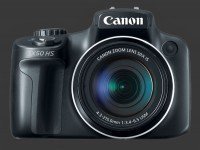
Sensor-Size: 6 x 5mm

Actual size when viewed at 100 DPI
| 12 Megapixels Ultra Zoom | ISO 80-6400 |
| 50X Ultra-Wide Optical Zoom | Shutter 1/2000-15s |
| Built-in Stabilization | Full manual controls, including Manual Focus |
| Unknown Size Built-in EVF 200K Pixels | Custom white-balance with 2 axis fine-tuning |
| 1 Axis Digital Level | Spot-Metering |
| 2.2 FPS Drive, 10 Images | Hot-Shoe |
| 1920x1080 @ 24 FPS Video Recording | Lithium-Ion Battery |
| 2.8" LCD 460K Pixels | Secure Digital Extended Capacity |
Updates
2025.01.18

Fujifilm GFX 2025 Lens Roundup
Lens Review roundup of Fujifilm GFX Medium-Format lenses. Quality, performance and handling of the GF20-35mm F/4R WR, GF30mm F/3.5 Tilt-Shift and the GF55mm F/1.7.
2024.11.18

Best 2024 Photography Gifts for Every Budget
Great gifts for photographers and photo enthusiasts selected for every budget among the best products of 2024.
2024.08.07

Eye Protection Tips for Professional Photographers
The four main considerations for professional photographers regarding eyewear.
2024.07.14

Fujifilm X100VI Review
Flagship fixed-lens compact digital camera with a 40 MP sensor and Image-Stabilization, a first for the series. Retro design featuring dual control-dials, plus direct ISO, Shutter-Speed and EC dials. Its hybrid viewfinder can switch between EVF and OVF mode.
2024.05.09

Fujifilm GFX100 II Review
Flagship 102 Megapixels Medium-Format Mirrorless Digital Camera with 8-Stop 5-Axis IBIS, 8 FPS Drive, 8K Video and 400 MP Super-Resolution capture in a weatherproof and freezeproof body with dual control-dials and dual memory-card slots.
2024.04.03

Fujifilm X-T5 Review
Newest Fujifilm flagship boasting a 40 MP APS-C sensor, 5-axis IBIS with 7-stop efficiency, 15 FPS continuous drive, 6.2K Video capture, dual control-dials and dual SDXC UHS-II slots in a sturdy weatherproof and freezeproof body.
2023.11.20

Best Digital Cameras of 2023
Find out which are the Best Digital Cameras of 2023. All the new Mirrorless Digital Cameras from entry-level to high-end professional.
2023.07.10

Fujifilm X-H2 Review
40 Megapixels APS-C Hybrid Mirrorless Digital Camera with 7-stop IBIS. Fastest shutter ever and 8K video capture. Large builtin EVF with 0.8X magnification and 5.8 MP, plus an Eye-Start Sensor. Packed with features and large number of controls in a weatherproof and freezeproof body.
2023.05.07

Sony FE 20-70mm F/4G Review
Review of the unique Sony FE 20-70mm F/4G lens. The optical zoom of this lens spans ultra-wide-angle and medium focal-length coverage, making it one of the most versatile Full-Frame lenses on the market.
2023.01.15

Huion Inspiroy Dial 2 Review
Review of the Huion Inspiroy Dial 2 tablet, a medium sized drawing surface with dual dials and customizable buttons. Connects via USB-C or Bluetooth 5.0 with Windows, Linux and Android support.
2022.12.08

How to Pack for a Photo Trip
Find out how to pack for a travel photography trip, carry your gear safely while meeting airline regulations.
2022.11.13

Best Digital Cameras of 2022
The best digital cameras of 2022. A short list of the most outstanding models in their respective categories. Choose one for yourself or as a gift.














